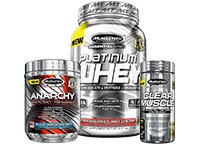
5 Ways To Prevent Gym Injuries
When it comes to fitness injuries, an ounce of prevention is worth a pound on the bar! Lift better and live better with these 5 scoops of wisdom earned the hard way!
Nothing short-circuits a workout program faster than an injury. It doesn't have to be the "snap city" kind, either. The real enemy is that troublesome shoulder injury that reminds you of its presence with each rep, or that hot spot in your elbow that just won't go away.
Some of this is inevitable, of course. But a little strategic prevention can also pay off immensely.
Let's look at a few of the top injury-prevention tips from people who make their living in fitness. Taking time away from the gym for them is not an option when contests and photo shoots loom, so staying pain-free is a top priority.
Form, Then Volume, Then Weight
Strength is all the rage these days. Plenty of men and women are posting PRs and following strength-focused programs. If you've been doing 5x5, 3x5, or anything with a five in it, congrats: You're building strength. But have you really earned it yet?
Here's what too few of the "how muchya" people won't tell you: You'll only benefit from lifting a heavy weight if you are using proper form. "Form should come way before the weight being lifted," NPC bikini athlete Katie Miller says. "If you lower the weight being lifted and focus on the mind-muscle connection, you'll avoid injuries and still see maximum results."
The lowering part—the eccentric half of a lift—can lead to a lot of strength and muscle gains, as well as strengthening connective tissues, so don't discount it. Until your form is rock solid, make the most of it and get your reps in. Let the weight creep up a bit, and then—only then—decide if you really, really want to go chase a big number.
Oh, and when you do go chase that number for the first time, save everyone around you a heart attack and use a spotter! "Whenever you're lifting with heavy weights, be sure that you have a spotter nearby," she says. "This will not only give you more confidence to push harder, but could really save you from a serious injury."
Respect Fatigue
Fatigue is a crucial ingredient in training. Your muscles and energy systems need it to get stronger and more efficient. But fatigue can be your enemy, too—especially when it makes your form lapse to the point that you suffer an injury.
So what's the answer? First, do what you can to delay fatigue for as long as possible. Miller swears by the classic quality-of-life stuff for that. "The best way to prevent injuries is to make sure that you are getting adequate amounts of sleep," she explains. "Also, make sure you are taking care of your water and nutrition intake before you train."
Even with eight solid hours and peerless nutrition, fatigue will happen. It's supposed to! But what you do when it comes calling is up to you. To help avoid injuries, figure pro Elissa Martis heeds its message. "If you do a lift or movement and it hurts or feels uncomfortable or off, this is your body telling you that you need to rest," she notes. "Don't push through the pain and fatigue."
And when you do decide to push the limits of your abilities, choose your movements wisely so that you can bail out without fear. For example: Dumbbell goblet squats to failure: probably OK. Overhead barbell squats to failure: probably not OK.
Find Your Frequency
You can find lots of information on the Internet telling you how often to train a certain muscle group. Some people will swear by once a week, others two, others more. Which one is right? Whichever one gives you the right amount of stimulus and enough space for recovery.
"For me, it's no more than two times per week," NPC bodybuilder Jesse Hobbs explains. "Training more often than what your body can handle is a fast way to get an injury."
Is it possible to do more? Of course, but only attempt it if you're confident in your recovery abilities and are following a periodized program where you aren't totally obliterating the same muscle with the same intensity every session.
"Training hard and killing yourself in the gym day after day without rest is just a recipe for an injury," personal trainer and MuscleTech athlete Lindsay Cappotelli
Once you fall in love with fitness and lifting, the idea of a total rest day can quickly lose its appeal. Like, what are you supposed to do? Sit there on your can all day? That's no fun! Let's do some arms and abs and cardio and hot yoga and ultimate Frisbee! Does that look like rest to you? I can guarantee it won't feel like it to your body. The take-home: Do what you want on your rest days, but don't do too much, and don't do it too intensely. And just for the record, pounding the pavement for an hour? Yeah, that's intense, particularly if you're already healing up from a tough leg workout. "Rest days can be active, but don't overdo any type of cardio that is high impact. It's surprisingly hard on your body, and it can get in the way of recovery and definitely lead to injuries," recommends fitness competitor Danielle Beausoleil. "If you want to do some cardio on a rest day, consider a lower impact activity such as stationary biking." I'm not talking about brushing your teeth or other forms of hygiene here—although I recommend you master them, too. I'm talking about fitness rituals like dynamic warm-ups and foam rolling. They may not be the magic bullet that keeps you from getting pinned under a loaded barbell, but athlete after athlete swears by them for helping produce better workouts and better recovery. "Injuries don't have to be catastrophic. They can come big or small," says fitness model and coach Shawn Russell. "To prevent them, I usually set up a few minutes to foam roll and perform some dynamic stretches before my workout session. This way, I release any tightness in my muscles, provide beneficial movement and blood flow to the joints, and raise my heart rate and body temperature to prepare for the workout ahead." After this work, he then does that classic five minutes of cardio before finally hitting the weights. After his workout, fitness model Jimmy Everett always saves time to stretch. "This is the point when your muscles are holding tension and could become very stiff and painful," he says. If you're the run-out-of-the-gym-and-into-the-car type—hey, it happens—then you can do your stretching and maybe some more rolling later at home. But do it! Whether in front of the TV or on the floor next to your bed, it's a great way to tell your body that the day is done and it's time to start recharging—so you can go back and do it all again, free of pain and full of fire!Rest on Rest Days, More or Less
Master Your Self-Care Rituals



